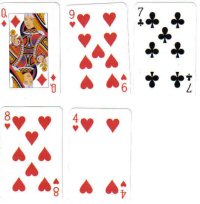|
Aim of the game The game is played with one standard pack of 52 playing cards and two players, who take it in turn to 'bat' and 'bowl'. The batsman scoring the most wins. Batting Determine who is to bat first (eg by toss of a coin). The person batting lays out two cards face-up, side by side. If they add up to 11 (say, nine and two), they may be covered by the following two cards. Aces count as one. In the more likely event that they don't add up to 11, then a third card is placed beside the original two. If any two of these three cards add up to 11 those two may be covered. Also, if a King, Queen and Jack are exposed all three may be covered. If this is not the case, a fourth card is placed in a row below the first card. This procedure is followed until there are three rows of three cards in a 3 x 3 square. All the while cards are being laid any pair that adds to 11 or any set of Jack, Queen and King may be covered. If at any point the batting player is unable to cover any cards their turn is finished. Count the number of cards laid and this forms their opening score. In the event that all 52 cards are laid, the batsman starts their turn again and any further cards will be added to the 52 already laid to make their score. |

